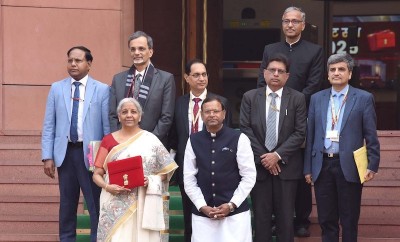
Strong macroeconomic fundamentals and resilient earnings growth to help Indian mutual fund industry sustain growth in 2024
Mumbai: The Indian mutual fund industry, which has witnessed a 125 percent surge in net inflows and around 24% percent growth in Assets under Management (AUM) since the beginning of this calendar year, is likely to sustain its growth momentum in 2024 backed by strong macroeconomic fundamentals of the Indian economy and resilient earnings growth, according to ICRA Analytics.
The net inflows into the mutual fund industry were to the tune of Rs 25,616 crore in November 2023, up from Rs 11,373 crore in January this year.
On a year-on-year basis, net inflows surged by 93 percent as compared with Rs 13,264 crore in November 2022.
“The new year is expected to be eventful where the industry is likely to witness continued inflows which would mimic the interest rate movements in the country. Global crude oil prices may continue to remain at lower levels,” said Ashwini Kumar, Head Market Data, ICRA Analytics.
Strong macroeconomic fundamentals of the Indian economy coupled with the possibility of an interest rate cut by the Reserve Bank of India if inflation remains under control, are some of the key factors that are expected to aid market sentiments moving forward.
The AUM of the domestic mutual fund industry has neared to Rs 50 lakh crore mark in November 2023 and is almost midway to the targeted aim of achieving Rs 100 lakh crore in the next few years.
The net AUM stood at around Rs 49.05 lakh crore as on November 30, 2023, up from Rs 39.62 lakh crore as on January 31, 2023.
“The fundamentals of the Indian economy remain intact which has insulated the domestic economy from global shocks. Continuation of the government’s reform agenda, prudent balancing of the fiscal and monetary policy, end of the global monetary policy tightening cycle and a possible interest rate cut by the Reserve Bank of India if inflation remains under control, will be some of the key factors driving higher inflows into the mutual fund industry in 2024,” Kumar said.
Key regulatory changes that changed the mutual fund landscape in India in 2023:
The capital market regulator SEBI (Securities and Exchange Board of India) has, during the year, permitted use of e-wallet for investment in mutual funds within the umbrella limit of Rs 50,000 per mutual fund per financial year.
The objective of the move was to channelise household savings into the capital market and promote digital payments in the mutual funds industry.
This apart, it is also mulling to sachetise mutual fund investments going forward.
SEBI is in discussion with mutual fund houses and evaluating ways to make SIPs (Systematic Investment Plan) of just Rs 250 a month viable.
The industry has been witnessing a surge in the number of SIPs, with the number of accounts reaching an all-time high of 7.44 crore in November 2023 compared to 7.30 core in October 2023.
The SIP assets under management (AUM) also witnessed a sharp uptick, scaling to Rs. 9.31 lakh crore for Nov 2023, as compared to Rs. 8.60 lakh crore in Oct 2023.
“Sachetisation will help drive the financial inclusion agenda and in turn boost the domestic equity markets. It will also channelise higher inflows through the SIP route thereby leading to greater participation of small retail investors,” he said.
SEBI has also allowed private equity funds to sponsor mutual fund schemes and permitted the set-up of self-sponsored asset management companies. The move is expected to facilitate fresh flow of capital into the industry, foster innovation, encourage competition, provide ease of consolidation, and ease the process of exit for existing sponsors,” Kumar said.
To develop the corporate bond market, SEBI has allowed asset management companies to participate in repos on Commercial Papers (CPs) and Certificate of Deposits (CDs). SEBI first allowed asset management companies to invest in repo in corporate debt securities in 2011.
The fund houses were then allowed to participate in repo transactions only in AAA rated corporate debt securities. Now asset management companies can participate in repos of listed AA and above rated corporate debt securities.
Higher inflows to sustain
Under equities, maximum inflows of Rs. 37,177.98 crore were witnessed in small cap funds till November 2023, while the mid-cap segment also witnessed healthy inflows and the momentum is expected to continue moving forward.
Equity funds witnessed inflows for 33rd consecutive month in November. Small-cap funds saw the highest inflows among equity funds at Rs 3,699 crore followed by mid-caps at Rs 2,666 crore and sector/thematic funds at Rs 1,965 crore.
Theme based funds, particularly relating to infrastructure, healthcare and IT, have been gaining steady traction.
While the interest in infrastructure-based funds in driven by an increased focus on sectors such as defence, railways and infrastructure and the government’s increasing focus on rural development through roadway expansion and setting up of new manufacturing plants in rural locales; that in healthcare is primarily due to increasing expenditure, as a percentage of GDP, reflecting the growing needs of an aging population.
This apart, the financial services sector is poised for growth, as India is entering a significant multi-year capex (capital expenditure) cycle, marking a pivotal moment for economic growth and prospects of an interest rate cut by the U.S. Federal Reserve in the middle of 2024 and lower possibility of a recession is expected to boost the domestic IT sector.
All these factors have been drawing investor interest in theme-based funds.
From the debt perspective, long term debt funds may benefit compared to its short-term counterparts. An interest rate cut by the U.S. Federal Reserve in the middle of 2024 coupled with impending flows in JP Morgan's bond index funds may lead to a decline in G-Sec yields.
So far during the calendar year 2023, maximum inflows were witnessed in arbitrage funds followed by index funds.
The spike in inflows in these segments could be attributed to the change in tax laws for the fixed-income mutual funds which took away the indexation benefit offered to investors until FY23.
Moving ahead, markets will be dictated by the outcome of the general elections slated to be held in 2024.
If the election outcome leads to policy continuity, this may be viewed as a positive for the markets.
However, if the outcome of general elections induces change, then there might be some correction in the market.
Incoming domestic macroeconomic data will be closely tracked as the same will dictate the stability of the domestic economy.
On the global front, global crude oil prices and monetary policy action by key central banks across the globe will also be on the investor’s radar.
In addition to the above-mentioned factors, the movement of the rupee against the greenback, and transaction trends by foreign institutional investors is also expected to have an impact on the markets.
Support Our Journalism
We cannot do without you.. your contribution supports unbiased journalism
IBNS is not driven by any ism- not wokeism, not racism, not skewed secularism, not hyper right-wing or left liberal ideals, nor by any hardline religious beliefs or hyper nationalism. We want to serve you good old objective news, as they are. We do not judge or preach. We let people decide for themselves. We only try to present factual and well-sourced news.







